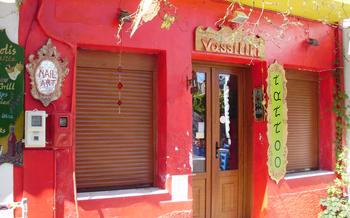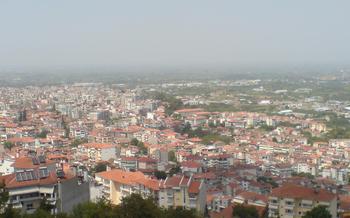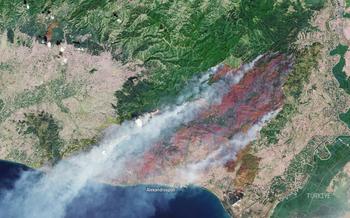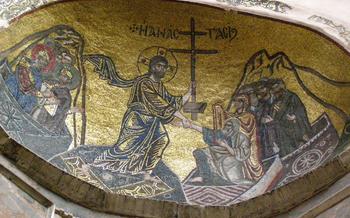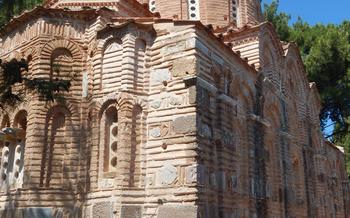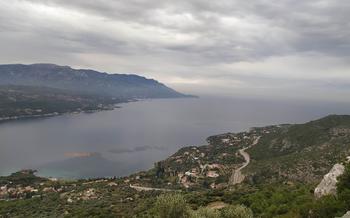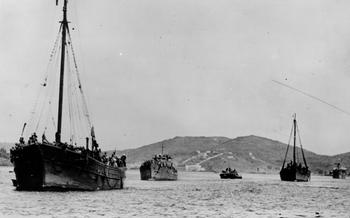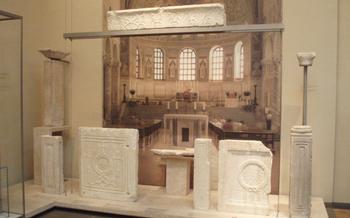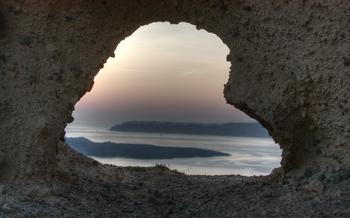
Moni Vronta
- Historical Background
- Location
- Architecture
- Interior
- Monastery Life
- Cultural Significance
- Visitor Information
- Photography Tips
- Personal Experience
- Local Cuisine
- Accommodation Options
- Transportation:
- Safety and Security:
- Accessibility:
- Insider Tip:
Historical Background
Established in the 16th century amidst the captivating landscapes of Samos, the Moni Vronta monastery stands as a testament to Greece's rich religious and cultural heritage. Founded by a humble monk named Neilos, the monastery quickly ascended as a spiritual beacon, attracting devout followers and pilgrims seeking solace and guidance. Its strategic location on the island's verdant slopes not only provided a sanctuary of tranquility but also allowed the monks to cultivate their own crops, ensuring self-sufficiency and independence.
Over the centuries, the Moni Vronta monastery has undergone several renovations and expansions, reflecting the architectural influences of various eras. Its sacred spaces encompass a magnificent main church adorned with intricate Byzantine-style frescoes, evoking the grandeur of a bygone era. Smaller chapels dedicated to different saints and adorned with exquisite iconography further enhance the monastery's spiritual ambiance. Legends abound within the monastery's walls, whispered tales of miraculous interventions and divine encounters that have shaped its enduring legacy.
Location
The Moni Vronta monastery is situated on the northeastern coast of the island of Samos, in Greece. It occupies a secluded and tranquil location, nestled amidst a lush forest of pine trees and olive groves. The monastery is perched on a hilltop, offering breathtaking panoramic views of the sparkling Aegean Sea and the surrounding countryside.
To reach the monastery, visitors can take a scenic drive or ride a bicycle along the winding roads that lead to the hilltop. The journey offers picturesque views of the island's lush vegetation, traditional villages, and the shimmering coastline. Alternatively, visitors can opt for a leisurely walk through the forest, enjoying the fresh air and the tranquility of nature.
The monastery is conveniently located near the town of Karlovassi, which is approximately 10 kilometers away. Karlovassi is a charming town with a vibrant atmosphere, offering a variety of shops, restaurants, and cafes. Visitors can easily combine a visit to the monastery with a day trip to Karlovassi, exploring the town's cultural heritage and enjoying the local cuisine.
The best time to visit the Moni Vronta monastery is during the spring or autumn months, when the weather is pleasant and mild. The summer months can be hot and crowded, while the winter months can be cold and rainy. However, the monastery's unique location amidst the forest provides a cool and shady retreat, even during the hottest days of summer.
Architecture
The Moni Vronta monastery exemplifies the architectural style prevalent in Byzantine and Greek Orthodox monasteries. Constructed in the 16th century, its design adheres to traditional principles of symmetry and balance. The monastery complex features a central church surrounded by auxiliary structures, forming a harmonious ensemble. The main church, dedicated to the Dormition of the Virgin Mary, boasts an impressive dome that dominates the skyline and symbolizes the monastery's spiritual significance. The exterior of the church is adorned with intricate carvings, delicate frescoes, and colorful mosaics, showcasing the artistic prowess of the era. The interior of the church is equally awe-inspiring, with its elaborate iconostasis, adorned with gold leaf and depicting scenes from the Bible. The monastery also houses several chapels, each with its unique architectural features and religious significance. The harmony and grandeur of the Moni Vronta monastery's architecture transport visitors to a bygone era, offering a glimpse into the rich history and cultural heritage of Greece.
Interior
The interior of the Moni Vronta monastery is a testament to the rich artistic and religious heritage of Greece. The main church, dedicated to the Dormition of the Virgin Mary, features a stunning array of Byzantine-style frescoes that depict scenes from the Bible and the lives of the saints. The vibrant colors and intricate details of these frescoes transport visitors back in time, offering a glimpse into the artistic traditions of the Byzantine Empire.
In addition to the main church, the monastery complex includes several chapels, each dedicated to a different saint or religious figure. These chapels are adorned with their own unique frescoes and iconography, creating a diverse and visually captivating spiritual environment. Among the most notable chapels is the Chapel of the Holy Cross, which houses a relic of the True Cross, believed to be a fragment of the cross upon which Jesus Christ was crucified.
The monastery also boasts an impressive collection of religious artifacts, including icons, manuscripts, and relics. These treasures are displayed in the monastery's museum, which provides visitors with an opportunity to learn more about the history and significance of the monastery. The atmosphere within the monastery is one of peace and tranquility. The soft chanting of the monks, the flickering of candlelight, and the scent of incense create a deeply spiritual and contemplative space. Visitors are encouraged to take some time to sit in silence and soak in the serenity of this sacred environment.
Monastery Life
The Moni Vronta monastery is home to a community of monks who dedicate their lives to prayer, study, and service. Following the principles of Greek Orthodox monasticism, the monks live a simple and austere lifestyle, centered around their faith and devotion to God. Their daily routine begins early in the morning with prayers and services, followed by work and various tasks to maintain the monastery and its surroundings. The monks also engage in spiritual reading, meditation, and contemplation, seeking to deepen their connection with God and their understanding of the scriptures.
They play a vital role in preserving the spiritual and cultural heritage of Greece, and their presence at the monastery contributes to the island's vibrant religious traditions. Visitors to the monastery may have the opportunity to witness the monks' daily rituals, such as the morning and evening prayers, and gain a glimpse into the contemplative and spiritual life that they lead.
Cultural Significance
The Moni Vronta monastery holds immense cultural significance in Greece, serving as a testament to the rich Orthodox Christian heritage of the country. Founded in the 16th century, the monastery has played a pivotal role in shaping the cultural identity of the island of Samos. Throughout its history, the monastery has been a center of learning, faith, and artistic expression, contributing to the island's cultural and spiritual landscape.
The monastery's architecture, with its intricate frescoes and iconic domes, reflects the Byzantine and post-Byzantine architectural traditions that have shaped Greece's cultural heritage. The monastery's collection of religious artifacts, icons, and manuscripts further enhances its cultural significance, providing a glimpse into the rich artistic and spiritual traditions of the Greek Orthodox Church.
The Moni Vronta monastery is not only a place of worship but also a symbol of resilience and continuity. Despite facing challenges and periods of decline throughout its history, the monastery has endured, thanks to the unwavering dedication of its monks and the support of the local community. Today, the monastery continues to be a vibrant center of religious and cultural life, attracting pilgrims and visitors from around the world who come to experience its spiritual atmosphere and rich heritage.
Visitor Information
Before embarking on your journey to the Moni Vronta monastery, it's essential to be well-informed about practical visitor information. The monastery's visiting hours are generally from 8 am to 12 pm and 3 pm to 6 pm daily, allowing ample time for exploration and contemplation. Admission to the monastery is free of charge, welcoming all visitors to experience its spiritual and historical significance without financial barriers.
Regarding dress code, visitors are expected to dress respectfully, adhering to the monastery's sacred nature. It is customary for both men and women to cover their shoulders and knees when visiting religious sites in Greece. While there is no strict dress code enforced, dressing modestly out of reverence for the monks and the monastery's sanctity is highly recommended.
If you're interested in delving deeper into the monastery's history and significance, guided tours are available upon request. These tours provide a unique opportunity to learn about the monastery's architecture, religious traditions, and the lives of the monks who call it home. Make sure to inquire about guided tour availability when planning your visit to ensure you don't miss out on this enriching experience.
To enhance your visit further, consider combining your trip to the monastery with other nearby attractions or activities. The island of Samos boasts a wealth of natural and cultural treasures waiting to be discovered. From picturesque beaches and charming villages to ancient ruins and hiking trails, there's something for every traveler in Samos. Explore the island's diverse offerings and create a well-rounded itinerary that caters to your interests.
Photography Tips
Capturing the beauty and serenity of the Moni Vronta monastery through photography is a rewarding experience. Here are some tips to help you take stunning photographs:
-
Early morning and late afternoon light: The warm, golden light of these times of day creates a magical atmosphere, perfect for capturing the monastery's architecture against the backdrop of the surrounding landscape.
-
Composition: Experiment with different angles and perspectives to create dynamic compositions. Try shooting from a low angle to emphasize the monastery's grandeur or from a high vantage point to capture the panoramic views.
-
Details: Don't forget to focus on the intricate details of the monastery's architecture, such as the intricate carvings, frescoes, and mosaics. These details add depth and character to your photographs.
-
Interior shots: If you're permitted to take photos inside the monastery, capture the serene atmosphere of the main church, chapels, and other buildings. Use a wide-angle lens to capture the grandeur of the interiors and pay attention to the natural light filtering through the windows.
-
Respectful photography: Remember to be respectful of the monks and other visitors when taking photographs. Avoid using flash or tripods inside the monastery, and be mindful of your surroundings to ensure you're not disturbing anyone's prayers or meditations.
Personal Experience
My visit to the Moni Vronta monastery was a truly unforgettable experience. As I stepped through the ancient gates, I was immediately struck by the sense of peace and serenity that permeated the air. The monastery's architecture, with its intricate carvings and colorful frescoes, transported me back in time, evoking a sense of awe and reverence.
During my visit, I had the privilege of meeting one of the resident monks, Father Ioannis. He graciously shared with me stories of the monastery's history and the daily life of the monks. His passion for his faith and his dedication to the monastery were truly inspiring.
One particularly memorable moment was attending the evening prayer service in the main church. As the monks' voices filled the air with their harmonious chants, I felt a profound sense of spirituality and connection to the divine. It was a truly magical experience that left me feeling uplifted and renewed.
I would wholeheartedly recommend visiting the Moni Vronta monastery to anyone interested in history, religion, or simply seeking a peaceful retreat. It is a place where the past and present intertwine, offering visitors a glimpse into the rich cultural and spiritual heritage of Greece.
Local Cuisine
Samos is a culinary paradise, offering a harmonious blend of Greek and Mediterranean flavors. The island's cuisine is renowned for its fresh seafood, succulent meats, and an abundance of locally grown produce. When visiting the Moni Vronta monastery, take the opportunity to indulge in some of the island's culinary delights. Try the traditional dish of "samos lamb," slow-cooked in a wood-fired oven with herbs and vegetables. For a taste of the sea, savor the grilled octopus or the freshly caught fish, simply prepared with olive oil, lemon, and herbs. Don't miss the chance to sample the local cheese, made from sheep's or goat's milk, and the sweet pastries filled with honey and nuts. For a memorable dining experience, visit one of the tavernas near the monastery, where you can enjoy authentic Samian cuisine while taking in the stunning views of the Aegean Sea.
Accommodation Options
When planning your visit to the Moni Vronta monastery, you'll find a range of accommodation options to suit different preferences and budgets. For a truly immersive experience, consider staying at the monastery itself. The monastery offers basic but comfortable lodgings for pilgrims and visitors, allowing you to fully embrace the monastic atmosphere and daily life.
If you prefer a more modern and luxurious stay, there are several hotels and resorts located within a short distance from the monastery. These offer amenities such as swimming pools, restaurants, and stunning views of the surrounding landscape.
For a more budget-friendly option, there are guesthouses and hostels available in nearby towns and villages. These provide a comfortable and affordable base for exploring the monastery and the island of Samos.
No matter your choice of accommodation, be sure to book in advance, especially during the peak tourist season, to avoid disappointment.
Transportation:
Reaching the Moni Vronta monastery is a breeze, with multiple transportation options available. For those without their own vehicle, public buses offer a convenient and affordable way to get to the monastery. Buses depart from various towns and villages across the island, with routes that pass near the monastery. Alternatively, taxis are readily available, providing a more direct and comfortable journey. For those seeking the freedom to explore the island at their own pace, renting a car or motorbike is an excellent choice. The roads on Samos are generally well-maintained, and finding parking near the monastery is usually not an issue.
Safety and Security:
Samos, and the Moni Vronta monastery in particular, are generally safe destinations for travelers. The island has a low crime rate, and the local community is known for its warm hospitality. However, as with any travel destination, it's essential to take basic safety precautions to ensure a smooth and enjoyable visit. Be aware of your surroundings, especially in crowded areas, and avoid walking alone at night. Keep your valuables safe and secure, and be wary of pickpockets. In case of an emergency, you can contact the local police or tourist office for assistance. Their contact information is readily available online or at your hotel's front desk. By following these simple safety tips, you can fully relax and enjoy your visit to the beautiful island of Samos and the historic Moni Vronta monastery.
Accessibility:
The Moni Vronta monastery is committed to providing an accessible and welcoming environment for visitors of all abilities. The monastery grounds are mostly wheelchair accessible, with ramps and designated pathways leading to the main church and other important buildings. Visitors with mobility challenges can also request assistance from the monastery staff, who are always willing to help. Additionally, the monastery offers accessible tours and programs that are tailored to the needs of visitors with disabilities. These tours provide detailed descriptions of the monastery's history, architecture, and spiritual significance, ensuring that everyone can enjoy and appreciate this sacred site.
Insider Tip:
For a truly unique and immersive experience, plan your visit to coincide with one of the special events or festivals held at the Moni Vronta monastery throughout the year. These events offer a glimpse into the rich traditions and customs of the monastery and provide an opportunity to connect with the local community.
One of the most popular festivals is the Feast of the Dormition of the Theotokos, celebrated on August 15th. This festival honors the Assumption of the Virgin Mary into heaven and attracts pilgrims from all over Greece and beyond. Visitors can witness a procession carrying the icon of the Virgin Mary, traditional music and dance performances, and a festive atmosphere that fills the monastery grounds.
Another highlight is the annual wine festival held in September. This festival celebrates the island's viticultural heritage and features wine tastings, local delicacies, live music, and traditional dancing. Visitors can sample a variety of local wines, including the renowned Muscat of Samos, while enjoying the lively atmosphere of the festival.
